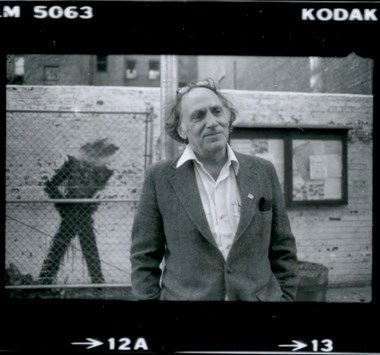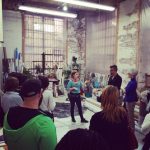Marketing 101: How to Share Your Story
“Your stakeholders are your audience with an already existing vested interest in what you do.”
Marketing is an essential tool for artists to share their work, grow their audiences, and build supporters. Yet, determining who the audience is and when and how to reach them can be challenging and time consuming tasks. Mara Vlatković, Digital Communications Officer at NYFA discusses practical strategies for individual artists to develop marketing plans, manage social media and websites and connect with supporters.
NYFA: As an individual artist or collective, what should my marketing plan include?
MV: First and foremost, a timeline. The marketing schedules will look different if you are working towards marketing a single event or creating a general marketing plan for your practice.
If you have a single event, performance or exhibition on the horizon, work back from that date. Think about when to announce it and then send out marketing materials such as (digital) flyers, visual assets, and create relevant online content. Consider when to conduct outreach to potential promotional partners. A marketing plan is primarily there to keep you accountable, so you don’t end up sending a save-the-date about your book launch two days before the event.
NYFA: How do I determine what platform will best help me share my project with my audience? Social media? Website? Blogs? A newsletter? Seriously, do I need all of them?
MV: Do you know where your target audience is spending most of their time? That’s where you have to share! Maintaining a mailing list is still essential. Email is the primary way of reaching your audience, making sure they know about what you’re up to, and giving them an easy way of checking back to find all the important information such as dates, address, RSVP details etc.
When it comes to other platforms, think about two things:
1) Where is your audience already and 2) What do you feel comfortable using consistently? If you don’t like writing, a blog or Twitter might not be the best platforms. You might want to opt for something more visual such as Instagram or Snapchat. The channels you use should have a consistent flow of content on them. Some require very frequent updates, others less so. Make sure you feel comfortable with the ones you use, otherwise delete them! Yes, this might be shocking advice, but if you have an old Twitter account where you last posted two years ago, it will reflect worse on you than not having a Twitter account at all.
NYFA: What types of information about my project might be ideal for sharing on social media? What types of information would be more appropriate for a blog post or newsletter?
MV: Social media is great for the immediate such as showing images or videos of your process, of work being made, rehearsals, backstage clips, studio images, the purchase of materials. You might consider these just day-to-day activities, but for your audience they are a rare glimpse behind the scenes. Your audience will thank you by following along, engaging and wanting to see the final artwork or event.
Reserve the longer content for blog posts and newsletters. This is where you can explain your motivation, your process and give more details about what you’re working on. It is good to have these posts on our website, so any social media content can link back to it in case your followers want to find out more.

NYFA: What are three things a strong blog post should include?
- A strong headline because it will make people click on your blog post in the first place.
- Be short. Blog posts shouldn’t be lengthy as people have very short attention spans online. I would recommend a maximum of 500 words.
- A call to action, which can be a link to RSVP or buy tickets, click through to another page on your website to find out more about the project, follow you on social media etc.
NYFA: What is the difference between my audience and my stakeholders? How can I best share my marketing materials with each group?
MV: Your stakeholders are your audience with an already existing vested interest in what you do. This could be based on relationships (family, friends, partners) or financials (investors, crowdfunding supporters, clients, repeat audience members), or both. These people will spread the word for you, will bring their own friends and support everything you do. It is always worth investing and dedicating some marketing time to these individuals. That could mean sending personalized emails about your upcoming project, sending printed invitations (never underestimate the power of getting physical mail in today’s world!), or giving them a quick call.
For your audience, consider how you can provide them with multiple ‘touch-points’. They could receive an email, then see a post on Facebook, and be able to follow the artwork in process through Instagram Stories. Using multiple communication channels means that they do not feel overwhelmed with information as it differs slightly in content, but they keep being reminded of you and your work.
NYFA: How do I measure if my marketing campaign for my upcoming event / screening / exhibition / performance, etc is “successful?”
MV: Determine for yourself what “successful” means. Is it the number of audience members in the room or tickets sold? Is it how much engagement you’ve received online? Or is it how many artwork sales you’ve made during opening night? All of those can be measured but slightly differently. Sales are easy to quantify. Engagement and audience building are harder to measure, but things such number of social media followers, online comments and likes help with that.

NYFA: How do I know who is liking, clicking, following me? Is there open source or low-cost software to keep track of this valuable data?
MV: Often the platforms offer a way to view your analytics. That’s the case for your Twitter account (https://analytics.twitter.com/) and on Facebook you can see analytics under the “Insights” tab. If you use an email marketing software such as Mailchimp or Constant Contact, you’ll be able to tell who opened your emails and who clicked on what link. Here is also a list of other websites that collects this data for you for free.
NYFA: How can I use search engine optimization (SEO) to help my website or blog appear at the top of the page on an Internet search?
MV: SEO is important and very useful for artist’s websites. I recommend doing some extended reading into this, as there are many intricacies. Some articles that can start you off: SEO for Artist Websites or SEO For Artists: Get Your Art In Google, Google Images, And Wikipedia.
NYFA: I am new to using technology to market myself. Are there resources to help teach me how Facebook works, what Twitter is and how to build a website?
MV: It’s great that you’re diving into using technology and digital tools for your marketing purposes! Click here for a useful Beginner’s Guide to Social Media and click here for a guide on How to Make An Artist Website.

Mara Vlatković is a communications professional and arts manager based in New York City. With previous experience in cultural diplomacy and international development in Washington DC, she has turned her focus on start-ups and organizations that support artists and creatives in fulfilling their full potential. She has a MA in Culture, Policy and Management from City University London and a BS in Sociology from the London School of Economics. Mara currently works at the New York Foundation for the Arts (NYFA) as the Digital Communications Officer and is the Founder of Young Professionals in the Arts (YPA).
Are you an individual artist or emerging organization interested in using NYFA Fiscal Sponsorship to expand your fundraising capacity? We accept applications quarterly and our next deadline is December 31, 2016. Learn more about the Fiscal Sponsorship program here and sign up for our free bi-weekly email, NYFA News here, for updates.
Image Credits: Leah Durner, Orange Grey Pour, photo by Bill Orcutt, 2014; Diana Mara Henry, Bill Kunstler on Gay St; Yoon Cho, We Have Traveled After.





